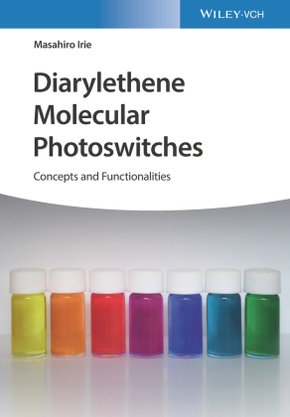Diarylethene Molecular Photoswitches - Concepts and Functionalities
| Verlag | Wiley-VCH |
| Auflage | 2021 |
| Seiten | 240 |
| Format | 17,7 x 1,7 x 25,4 cm |
| Gewicht | 618 g |
| Artikeltyp | Englisches Buch |
| ISBN-10 | 3527346406 |
| EAN | 9783527346400 |
| Bestell-Nr | 52734640A |
A comprehensive review to the synthesis, properties, and applications of diarylethene-based molecular photoswitches
Diarylethene Molecular Photoswitches: Concept and Functionalities provides the fundamental concepts of molecular photoswitches and includes information on how the bistable photoswitches of diarylethenes modulate the functions of materials and biological activities. Written by Masahiro Irie (the inventor of photochromic diarylethene compound), the book explores the reaction mechanism, photoswitching performance, photoswitchable crystals, and the myriad applications of diarylethenes based photoswitches.
This book offers academics, chemists, and engineers an essential resource for understanding the molecular photoswitches and provides a guide to the development of new photoresponsive materials. The author explores the applications based on diarylethene and its dirivatives to Field-Effect Transistors, Metal-Organic Frameworks including nanoparticles, s uper-resolution fluorescence microscopies, drug release, and self-healing materials. This important book:
_ Offers a guide to diarylethene derivatives, the most widely studied compounds worldwide among the photochromic compounds
_ Includes the basic concepts of molecular photoswitches
_ Explores the myraid applications grounded in diarylethene and its derivatives
_ Presents an authortative text from the inventor of the photochromic diarylethene compound
Written for materials scientists, organic, polymer, and physical chemists, and electronics engineers, Diarylethene Molecular Photoswitches offers an introduction to the topic and includes recent developments in the field.
Inhaltsverzeichnis:
1. Introduction
1.1 General Introduction
1.2 Discovery of Diarylethene Molecular Photoswitches
2. Reaction Mechanism
2.1 Basic Concepts
2.2 Theoretical Study
2.3 Reaction Dynamics
2.3.1 Cyclization Reaction
2.3.2 Cycloreversion Reaction
3. Photoswitching Performance
3.1 Quantum Yield
3.1.1 Photocyclization Quantum Yield
3.1.2 Solvent Effect on Cyclization Quantum Yield
3.1.3 Photocycloreversion Quantum Yield
3.2 Thermal Stability
3.3 Fatigue Resistance
3.4 Fluorescence Property
3.4.1 Turn-off Mode Photoswitching
3.4.2 Turn-on Mode Photoswitching
3.5 Chiral Property
4. Photoswitchable Crystals
4.1 Dichroism
4.2 X-Ray Crystallographic Analysis
4.3 Quantum Yield
4.4 Multicoloured Systems and Nano-layered Periodic Structures
4.5 Fluorescent Crystals
4.6 Photomechanical Response
4.6.1 Surface Morphology Change
4.6.2 Reversible Shape Change
4.6.3 Bending Response of Mixed Crystals
5. Memory
5. 1 Single-Molecule Memory
5.2 Near-Field Optical Memory
5.3 Three-Dimensional Optical Memory
5.4 Readout using Infrared (IR) Absorption, Raman Scattering and Refractive Index Changes
6. Switches
6.1 Single-Molecule Conductance Photoswitch
6.2 Optical Switch based on Refractive Index Change
6.3 Magnetism
7. Surface Properties
7.1 Surface Wettability
7.2 Selective Metal Deposition
7.3 Subwavelength Nanopatterning
8. Polymers and Liquid Crystals
8.1 Polymers
8.2 Liquid Crystals
9. Applications
9.1 Organic Field-Effect Transistors (OFETs)
9.2 Metal Organic Frameworks (MOFs)
9.3 Super-resolution Fluorescence Microscopy
9.3.1 Control of Cycloreversion Quantum Yield
9.3.2 Fatigue Resistance
9.3.3 Photoswitching with Single-Wavelength Visible Light
9.3.4 Super-resolution Bioimaging
9.4 Chemical Reactivity Control
9.5 Biological Activity
9.6 Colour Dosimeters
10. Appendix

